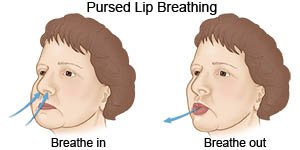Pulmonary Fibrosis
Medically reviewed by Drugs.com. Last updated on Aug 4, 2025.
Pulmonary fibrosis is the scarring of your lung tissues over time. It is also called interstitial lung disease. The air sacs and tissues in your lungs swell, scars form, and the tissues become thick and stiff. This affects how much oxygen you get and makes it hard to breathe.
 |
DISCHARGE INSTRUCTIONS:
Call your local emergency number (911 in the US) if:
- You have sudden severe trouble breathing.
- You have a fast heartbeat or chest pain.
- Your shortness of breath gets worse.
- You feel so dizzy that you cannot stand up.
Call your doctor or pulmonologist if:
- You have a fever.
- You cough up bloody mucus.
- You are wheezing.
- Your lips or fingernails turn blue.
- You have swelling in your legs or feet.
- You need more oxygen than you used to.
- You have questions or concerns about your condition or care.
Medicines:
- Medicines may be given to decrease lung tissue swelling and help prevent scarring.
- Take your medicine as directed. Contact your healthcare provider if you think your medicine is not helping or if you have side effects. Tell your provider if you are allergic to any medicine. Keep a list of the medicines, vitamins, and herbs you take. Include the amounts, and when and why you take them. Bring the list or the pill bottles to follow-up visits. Carry your medicine list with you in case of an emergency.
Manage pulmonary fibrosis:
- Use oxygen at home as directed. Oxygen is usually given through a nasal cannula. This is a pair of short, thin tubes that rest just inside your nose. Tell your healthcare provider if your nose gets dry or if the skin gets red or sore. Never smoke or let anyone else smoke in the same room while your oxygen is on.
- Do breathing exercises as directed. Breathe out with pursed or puckered lips. Use your diaphragm to breathe. Put one hand on your abdomen and breathe in, causing your hand to move outward or upward. This helps make more room so your lungs can take in more air.

- Go to pulmonary rehab as directed. Specialists will help you safely strengthen your lungs and prevent more tissue damage. The plan includes education about your condition, exercise, breathing strategies, and ways to conserve energy. Pulmonary rehab may help decrease your breathing problems and help you function better in your daily activities.
- Get the flu vaccine. The flu can become serious in anyone who has a lung condition. Get the flu vaccine as soon as recommended each year, usually in September or October. You may also need the pneumococcal vaccine to prevent pneumonia.
- Do not smoke. Nicotine and other chemicals in cigarettes and cigars can increase the damage to your lung tissue. Ask your healthcare provider for information if you currently smoke and need help to quit. E-cigarettes or smokeless tobacco still contain nicotine. Talk to your healthcare provider before you use these products.
Treatment options
The following list of medications are related to or used in the treatment of this condition.
Follow up with your doctor or pulmonologist as directed:
You may need to return for more CT scans or pulmonary function tests to monitor your condition. Write down your questions so you remember to ask them during your visits.
© Copyright Merative 2025 Information is for End User's use only and may not be sold, redistributed or otherwise used for commercial purposes.
The above information is an educational aid only. It is not intended as medical advice for individual conditions or treatments. Talk to your doctor, nurse or pharmacist before following any medical regimen to see if it is safe and effective for you.
Learn more about Pulmonary Fibrosis
Treatment options
Care guides
Further information
Always consult your healthcare provider to ensure the information displayed on this page applies to your personal circumstances.
